When nonprofits run online fundraising campaigns, it’s easy to only focus on the big picture—hitting that overall fundraising goal. But for donors, especially those giving smaller amounts, it can be hard to see how their contribution really makes a difference. The good news? People are more likely to give (and even give more!) when they clearly understand their impact. That’s where donation tiers come in.
By using CauseVox’s free, easy to use fundraising platform you can set up customizable donation tiers, showing donors exactly what their gift accomplishes. CauseVox makes it easy to create high-converting donation pages while providing a seamless donor experience, allowing you to raise more while keeping the focus on your mission.
Not sure how to define your donation tiers? Don’t worry. We are going to dive into 5 types of donation tiers that engage donors and drive donations.
What Are Donation Tiers?
A donation tier is basically a way to show donors exactly what their gift can do. Instead of just asking for $25, $50, or $100, you give those amounts real meaning—like “$25 provides school supplies for one student” or “$100 feeds a family for a week.” It helps donors connect their contribution to a tangible impact, making them feel more confident and excited about giving. Plus, when people see what their donation can accomplish, they’re often inspired to give more!
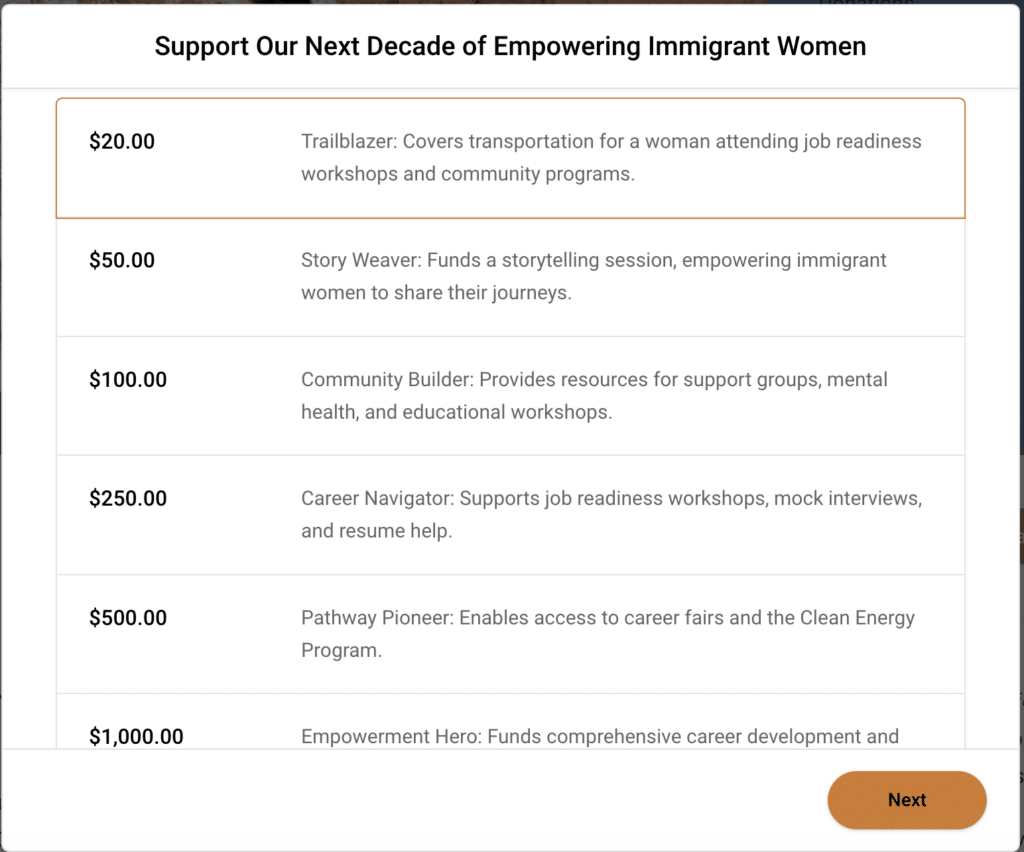
With CauseVox, you can easily customize your donation tiers based on your organization’s fundraising goals.
Dive deeper into all you need to know about building your donation page with our free guide below.
Download the Complete Guide To Building Your Donation Page:
Donation Tiers Best Practices
Before getting specific about the ways you can set up donation tiers, there are a few best practices that can help you select the right amounts for your tiers.
- We recommend creating about 4-6 donation tiers. This allows your donors to easily select the right tier for them, without being overwhelmed with their options. In the same vein, keep your donation tier descriptions short and easy to read.
- The average donation on CauseVox is about $78, so we recommend creating one tier that’s around that benchmark and creating one over $150. However, if you know your average donation amount, we recommend creating your tiers based on your own data.
- If you’re using CauseVox’s Impact Metric, which is a counter on your site that displays the units of impact your fundraising campaign has reached, it’s best to tie your donation tier back to your units of impact.
These best practices can help you create donation tiers that engage and appeal to your audience.
5 Types Of Donation Tiers That Drive Donations
Donation tiers don’t come in just one shape and size, your amounts and the description of those amounts can vary based on the campaign and what your nonprofit does.
Here are five ways I’ve seen various types of nonprofits break down their impact into tiers that drive donations.
1) Person-to-Person
One of the things we often say here at CauseVox is that people give to people, not organizations. And by this, we mean that people are motivated to give when they feel an emotional connection with the people their donation benefits.
Studies have shown that when a person feels they’re giving to someone in need, the donor experiences a positive emotional impact, which can drive people to give higher donation amounts.
What better way to communicate this than by quantifying the impact of a donation in terms of how many people will benefit from it?
If your campaign is working to raise funds that will provide a service for a certain number of people, it’s in your best interest to use each donation tier to describe how many people it will impact for each amount. This will help take the focus of your donors off the donation amount, and instead compel your donors to ask themselves how many people they want to impact.
Here’s an example of person-to-person donation tiers used on Orangewood Foundation’s campaign:
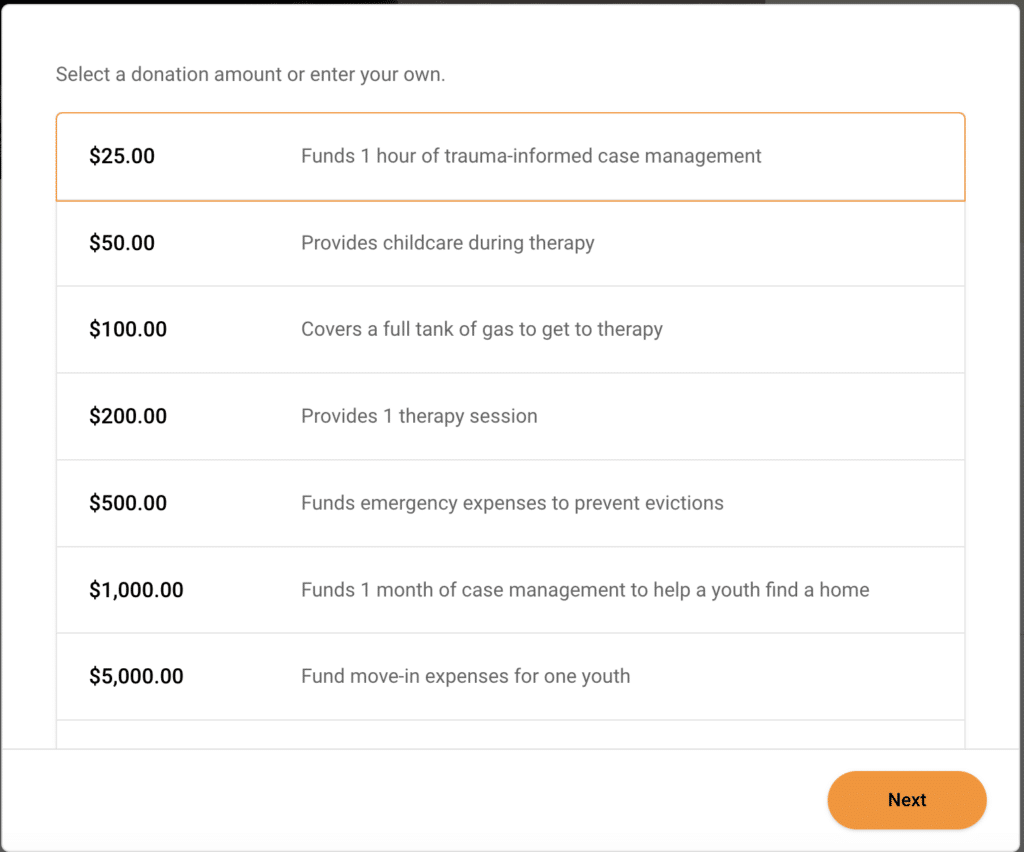
When considering using the person-to-person tier approach, ask yourself a few questions:
- How many people will my overall fundraising goal impact?
- Is that total dispersed fairly evenly over all the people impacted?
- Am I fundraising to meet one type of need, or are the needs of the people I’m serving varied?
This person-to-person approach works well for campaigns that are working to provide a specific service to a certain number of people.
2) Item-Based
Similar to the person-to-person tiers are item based tiers. These can be implemented when your organization provides tangible items, materials, or experiences that are distributed directly to the people it supports.
Item-based donation tiers help illustrate donation amounts. This gives donors the ability to tie their donation to the value of an item or service it provides to the people you serve.
Here’s an example from Neil Squire, who provides accessible play for kids with disabilities.
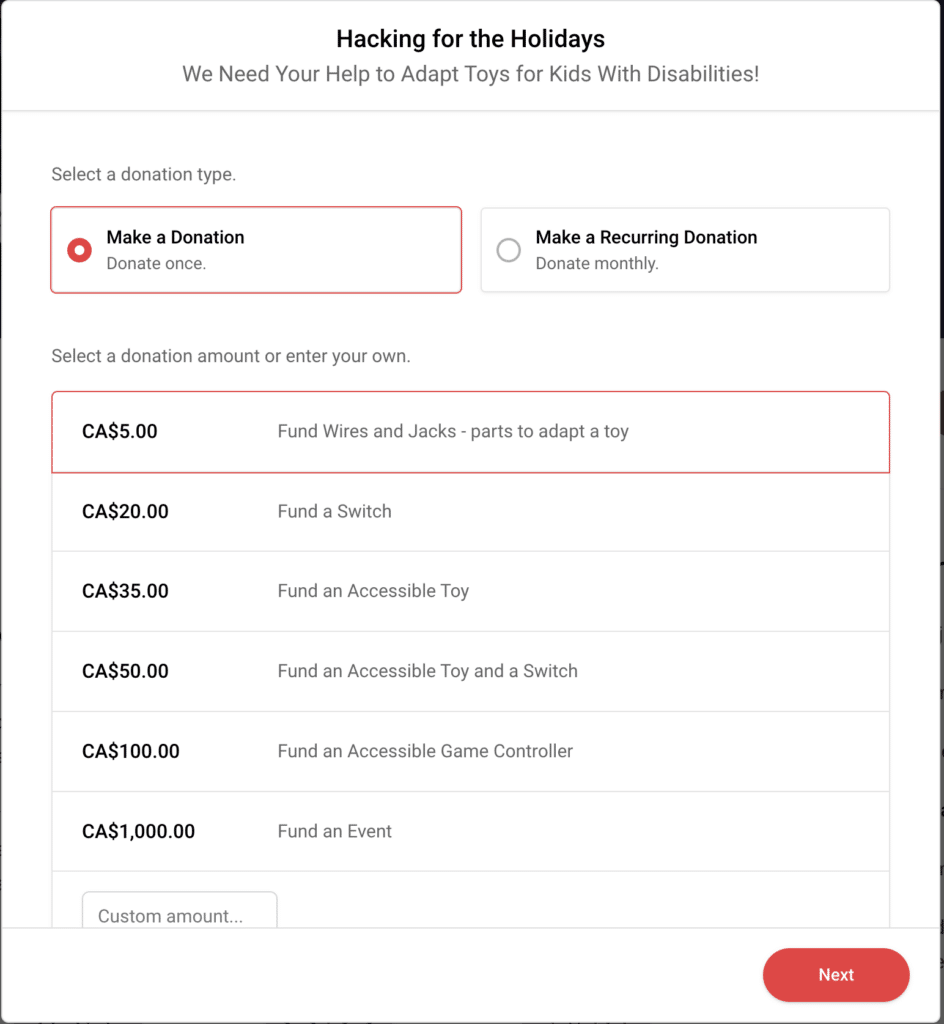
When considering using the item based framework, ask yourself a few questions:
- Do we provide a specific item or service to the people we support?
- Can we break down one item into any smaller items tied to a specific cost?
With this item-based framework, donors get an idea of how their funds could be used, which increases their trust in your organization.
3) Time-Based
Maybe you’re not able to break your donations tiers down into specific units of quantifiable impact that’s people or item based, such as when you are working on a project that’s more long term.
For these kinds of campaigns, you’ll want to consider breaking up your tiers into the number of hours, days, weeks, or months of work that the funds donated are working to provide.
For example, The Motherhood Collective’s Maternal Health Matters campaign, primarily broke down their donation tiers into the months of a particular program that each donation tier would fund.
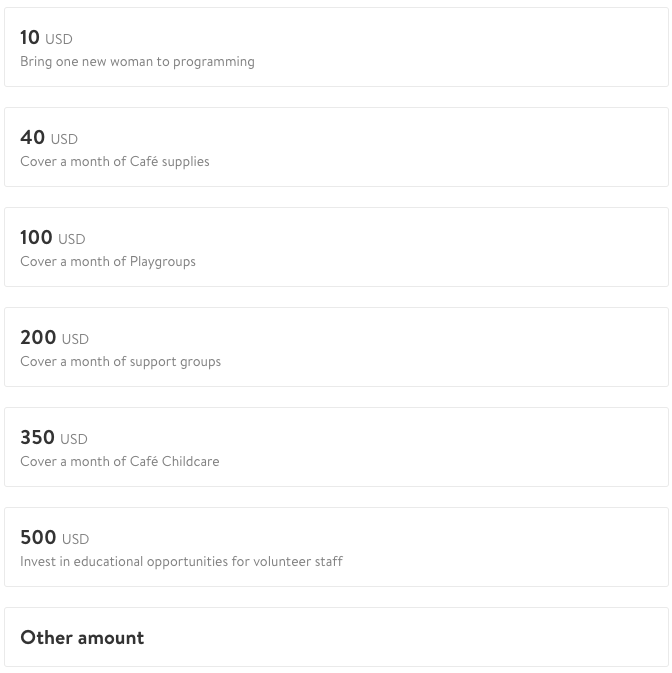
When using time-based donation tiers, ask yourself a few questions:
- How long will it take to complete the project or service?
- What specific amounts of funds can you designate to different things, so that you can easily break down where the funds will go? (ie: Is $3500 going to one program, and $5000 another?)
- Broken down into months, weeks, days, and hours, what do the amounts come down to that make the most sense for approachable donation tiers?
You’ll want to consider using time-based donation tiers if you’re:
- Looking to raise funds for an entire project or program.
- Raising funds to build or complete something.
- Raising funds to provide a service, like therapy or healthcare.
4) Recognition And Rewards
If you’re unable to quantify your work in terms of the impact the donor creates, the second best thing is to drive donations with recognition or rewards.
Using tiers is a great way to recognize donors for their particular contributions to your fundraising campaign. Many donors like to have recognition for their gifts, and different levels can help influence them to make a higher donation.
Here’s a look at Deaflympics’ donation form:
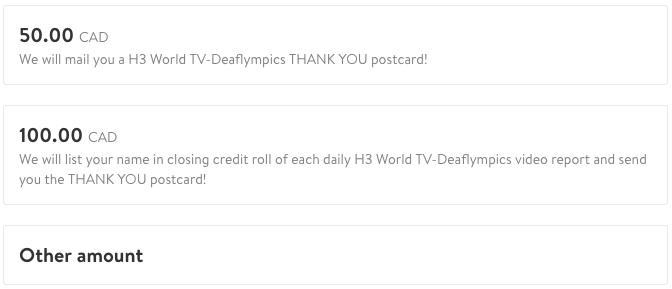
While they only have two tiers, they describe in detail different levels of how the donor will be thanked and recognized. This is a great way to encourage donations, since it’s cost effective for nonprofits but still drives donations.
Alternatively, you can take a more rewards based approach, offering things like t-shirts or a chance to win a larger prize. Donors feel that they’re receiving something in return for their donation, and this may drive them to give higher amounts to receive certain rewards.
If you’d like to set up recognition based tiers, here’s 21 Unique Donor Thank You Ideas to help you brainstorm ways you can recognize your donors.
Thank yous and rewards are a great fit for a campaign that’s raising funds for something that can’t be broken down into specific funding categories, such as Cancer Research or some kinds of capital campaigns.
5) Titles
For when your campaign is not quantifiable in easy-to-consume terms, and you don’t want to take a rewards approach, you can always assign related titles to donors at different levels of giving.
While some organizations allow donors to choose from bronze to platinum, it’s always engaging to try and relate your titles to your campaign’s theme.
For example, the Charlie Ward Champions Ranch ran a capital campaign and used titles to define their donation tiers.
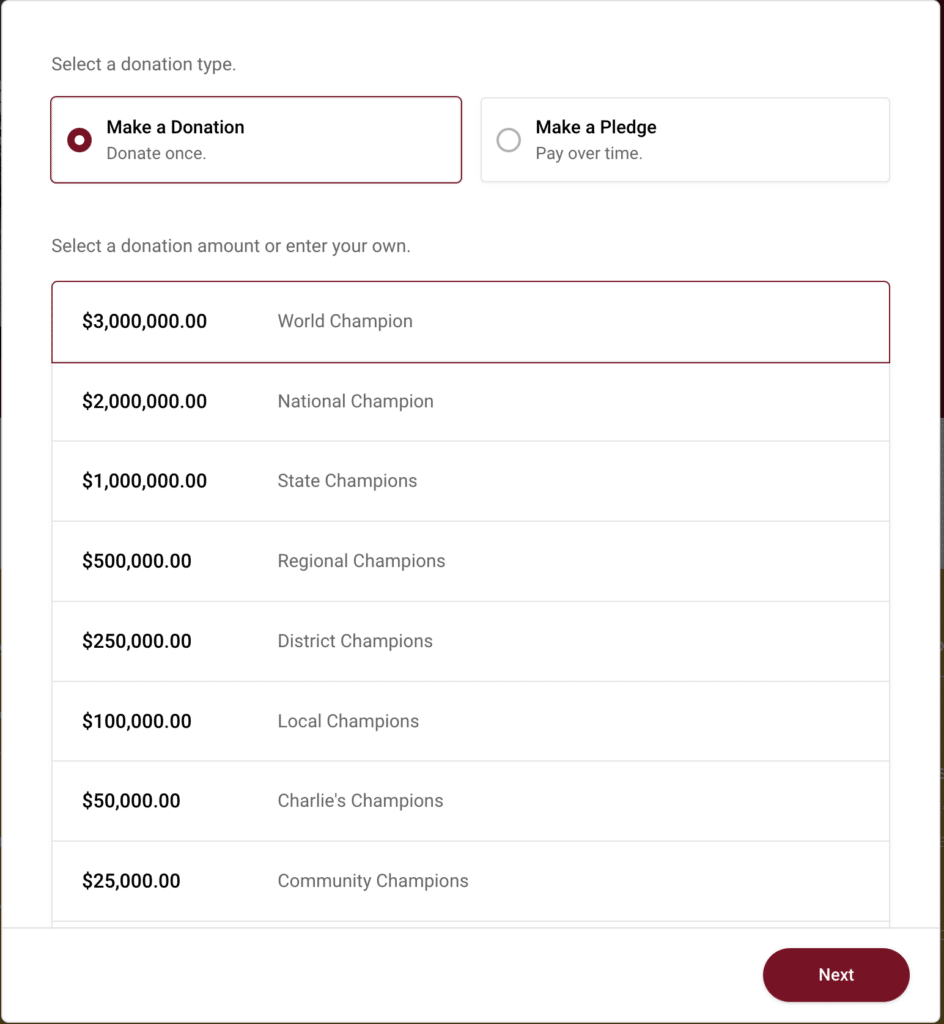
This is the perfect way to spice up your campaign and encourage donors to choose their donation tier not just on amount, but also by the label they assign with it. It makes the donation more personal.
Building Donation Tiers With CauseVox
CauseVox offers a user-friendly platform for creating free donation pages with easy integration of donation tiers. Through CauseVox’s intuitive interface, you can effortlessly add and customize donation tiers, utilizing any of the frameworks mentioned above. If you see a few types of frameworks that you can fit in your donation tiers, feel free to mix and match! It’ll only help to deepen the donor’s understanding of what your organization does and what their gift can accomplish.
Ready to boost your fundraising and make every donation count? Start building your donation form with impactful donation tiers on CauseVox—it’s totally free. Show donors the difference they can make and watch your donations grow. Get started today!
This post was originally posted in July 2017 and was updated for freshness and accuracy in March 2025.




